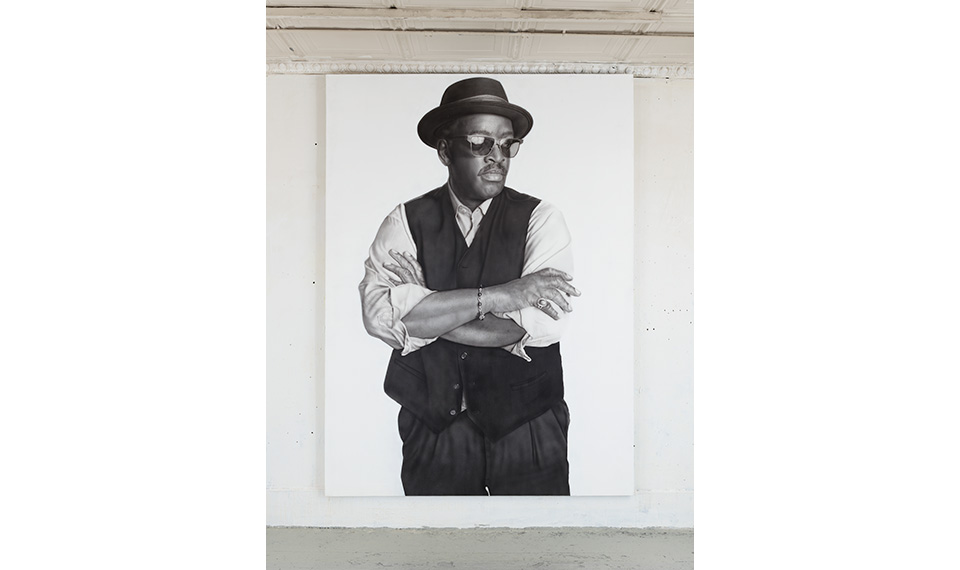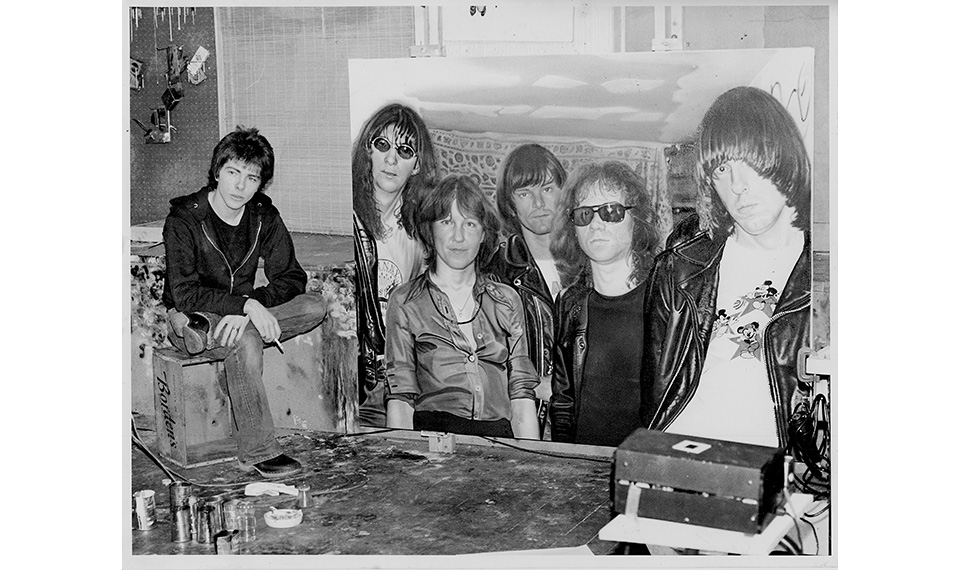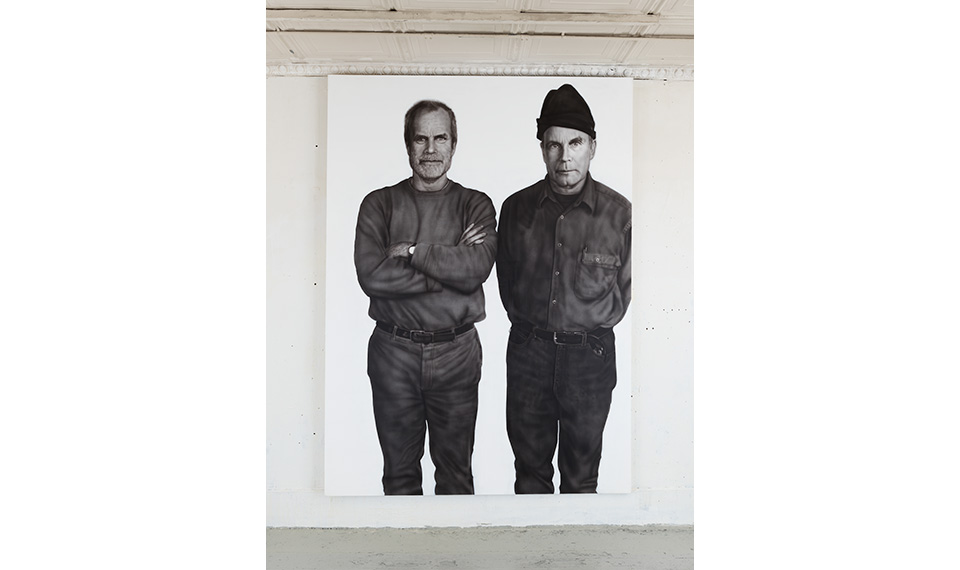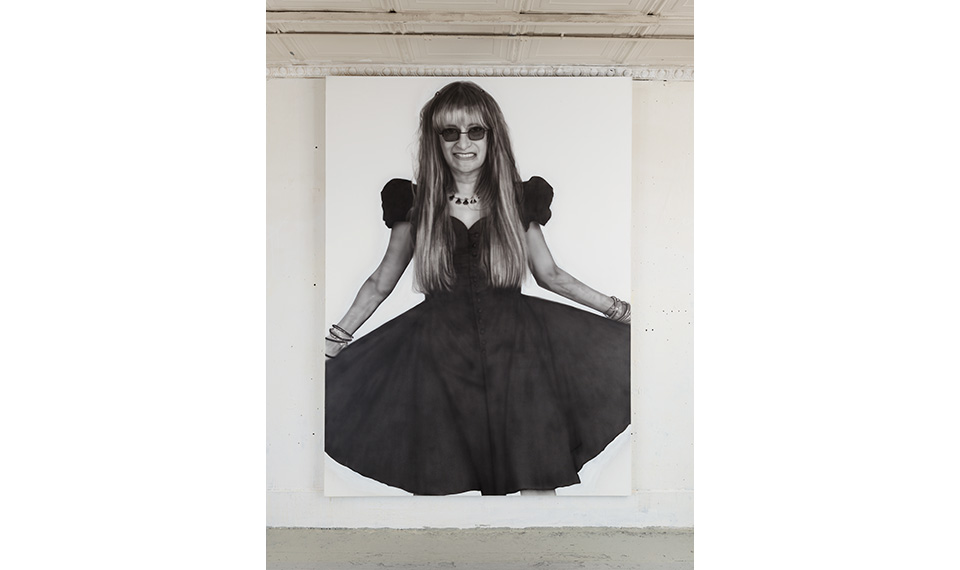Photo-Realized: The Downtown Portraits at Howl
Richard Boch talks to artist Curt Hoppe about his larger-than-life portrait paintings.
What better place to discover a portrait of Downtown New York City than the once-lost and legendary stretch of Bowery between Houston and Delancey? Artist and photographer Curt Hoppe lives there, his studio is there, and it’s where his camera work and painted images become one.
Hoppe was born in Minneapolis and grew up in a home that was Mississippi River adjacent—a dangerous location for a curious young mind. In time, he spent a few years winding his way through the art department at the University of Minnesota. An encounter with painting and Photorealism at the Walker Art Center—along with the genre’s modern spin on large-scale portraiture set the path forward—and the timing of Hoppe’s 1978 next move to New York City was perfect. His previously noted inquisitive mind quickly found a fellowship of like-minded spirits within the mid to late-seventies cultural eruption taking place downtown and centered around the legendary clubhouse-dive bar music venue that was CBGB.
As part of that growing community of young artists, musicians and filmmakers living in and around New York’s East Village and Lower East Side, Hoppe found himself somewhere between the thick of it and the heart of the scene. It was fast times in a fast lane that was laced with drugs, alcohol and the pounding beat of what can only be described as a late-night hyperdrive of inspiration and creativity. Somehow—in spite of, or because of the distractions—people found time to do the work that would establish and propel their careers. Whether we’re talking Basquiat or Blondie, Fab 5 Freddy or the Ahearn Twins, they all helped fuel the energy that drove the Downtown happening into what was then, now and hopefully continues to be.
Curt Hoppe like many of us found family in that community and, as he moved fast-forward into the new millennium, continued making friends and taking photographs. The subjects looking into Hoppe’s camera lens and appearing on his canvases were the Downtown partners-in-crime he had come to know and love. Then, in 2010, his fast friendship with Arturo Vega, the Ramones creative director—often referred to as the fifth Ramone and the namesake of HOWL Happening: An Arturo Vega Project—put the larger-than-life portrait paintings in motion. Vega was the first, and in a sense the catalyst for what would become Hoppe’s series of masterfully executed and photo-realized large-scale body of work. I’ve had the opportunity not only to see Curt’s smaller-scale photographs (of which I have the honor to be included) but nearly all of the larger-than-life painted canvases, too. They are Curt Hoppe’s Downtown Portraits at HOWL—a mind-blowing array of faces and personalities—and a must-see for anyone interested in the who, what and where of the Downtown experience.
I’ve been talking to Hoppe about the here and now—the highs and the lows of where we all came from—and how the very idea of that unsustainable wild-time grew into some storybook moment, seemingly left to legend and history. Hoppe’s Downtown Portraits capture some of the visionaries who created that once dreamlike reality along with the enduring myth of Downtown New York City.

Fred Brathwaite aka Fab 5 Freddy (2012) by Curt Hoppe. Acrylic on Canvas 96” x 70”. Courtesy of Howl! Arts.
Richard Boch: Hi Curt. I do love revisiting this series of yours. The photographs and especially the paintings stir both memories and emotions. Let’s get back to all that in a moment but for now let’s talk about when you first picked up a camera and a paintbrush. Like the chicken or the egg—which came first?
Curt Hoppe: Well, they both came around the same time when I was a kid. I started out scribbling and my mother collected all those drawings and stuck them on the refrigerator. My dad had one of these Rollei Rolleiflex cameras—so he gave me his old one and I would walk around my neighborhood taking pictures of things I found interesting, which was mostly signage. I loved signage and I made an actual living when in college, even in high school painting signs. There was this coffee house near my school in Minnesota called the Ten O’clock Scholar in a neighborhood called Dinkytown. Bob Dylan had played there in his early troubadour days and they hired me to make signs for whatever musicians might be passing through.

Colette Lumiere (2011) by Curt Hoppe. Acrylic on Canvas 96″ x 70”. Courtesy of Howl! Arts.
RB: That’s great, and it really says a lot about how the paintbrush and camera went hand in hand for you even in those early years. So then from Minnesota, you arrived in New York City and found a loft on Bowery—a space that you still live and work in today. The location was considered the edge of Chinatown, a bit rough and tumble but youth was still on your side. How did you find it and what kind of shape was the place in? Did walking distance to CBGB figure into that chosen location?
CH: There was an ad for the loft in the Village Voice, and the place was definitely walking distance to CBGB. The neighborhood was still the old bodies-in-the-doorway Bowery that everyone talks about. The space itself was raw, pretty much empty and anything that previously existed was makeshift. I just gutted the place and being a Minnesota boy, I was already handy with a circular saw so I remodeled the loft myself. I was actually a pretty good carpenter, so in between the way too many nights at CBGB and Mudd, I was able to build a home and studio.

Hoppe with his painting ‘Bettie and the Ramones’, 1978. Photo Miller and Ringma. Courtesy Marc Miller.
RB: Getting into your creative process and the origins of the Downtown Portraits, there’s a wonderful and rather famous photo of you sitting next to a painting of the Ramones and the legendary downtown denizen Bettie Ringma. Tell me how this photo and the painting came to be? You were still very much a kid, yet the concept and your technique is pretty sophisticated.
CH: Bettie lived upstairs from me with Marc Miller of Gallery 98 and they were working on a project called “Paparazzi Self Portraits” where you’d place yourself into a photo of a famous person or persons. Bettie managed to place herself in photos with nearly every band that ever played at CBGB. Where I fit in is that I painted that four-by-six-foot version of the photo with Bettie and the Ramones. This was still 1978 and it turned into a conceptual piece with all four Ramones signing the painting—and the videographer Paul Tschinkel capturing the moment.

John and Charlie Ahearn (2011) by Curt Hoppe. Acrylic on Canvas 96” x 70”. Courtesy of Howl! Arts.
RB: Your series of portrait paintings came about much later beginning in 2010—but if we’re talking late 1970s and early 1980s, Bowery was certainly still a ground zero when it came to meeting people, making friends and discovering who and what we were all about. It’s where you came to know your great friend Arturo Vega along with a number of people who also became partners-in-crime as well as subject matter for what would become the Downtown Portraits. Did you look at people you were meeting and think, I’ve got to take their photo and turn them into a giant eight-foot-tall painting? How did the obsession and the process begin?
CH: Oh no, I just became friends with people that I got to know from hanging out at the clubs—everywhere from CB’s, Mudd and then later at Area and Danceteria. I got to know people as I was introduced to the art world, people like Diego Cortez who included me in New York/New Wave, the 1981 show he curated at P.S.1 in Long Island City. Another interesting connection was when it was my turn to do a “Paparazzi Self-Portrait” and I did one with Al Goldstein, the publisher of SCREW Magazine. Al liked the painting I did of our Paparazzi portrait and asked if I could paint nudes. I said sure, of course I can—and he offered me a job. That was kind of a big break too.

Marcia Resnick (2012) by Curt Hoppe. Acrylic on Canvas 96” x 70”. Courtesy of Howl! Arts.
RB: What’s left for me in all this is hearing you talk about the friends you’ve photographed and painted as being like family. Is that the kind of bond, formed over the years, that made Downtown the cultural hub, social mecca, and in a way, a state of mind that still exists to this day?
CH: I don’t know if that state of mind still exists because truthfully, I can’t figure out what’s going on today. I do know there’s a tremendous amount of interest in what the good old days were like. What people don’t realize is that besides all the fun, we all had to fight to hang on to our places as the neighborhoods changed, and we succeeded in doing that. The best way for me to look at all of this is like we were part of a high school class—maybe call it the Class of 1978—and I wound up painting and photographing my peers or classmates. I just wanted to leave a legacy.
RB: Curt, thank you, that last thought of yours is beautiful and I just love seeing the Downtown Portraits at HOWL.
***
July 11 – August 11 2024
HOWL Happening 6 East 1st Street, New York
INTERVIEW Richard Boch
PHOTOGRAPHY Courtesy of Howl! Arts
Richard Boch writes GrandLife’s New York Stories column and is the author of The Mudd Club, a memoir recounting his time as doorman at the legendary New York nightspot, which doubled as a clubhouse for the likes of Jean-Michel Basquiat, Keith Haring, Debbie Harry and Talking Heads among others. To hear about Richard’s favorite New York spots for art, books, drinks, and more, read his Locals interview—here.